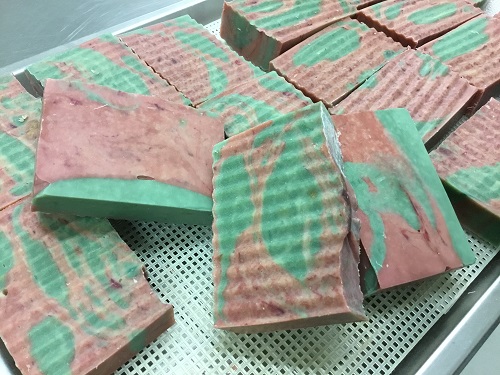
Goat’s milk soap is famous for being mild on the skin and great for people sensitive to chemicals or even other soaps. I make it regularly, and it does not take much more effort than water-based cold-process soap, so why not give it a go?
Ingredients:
- Goat’s milk (pasteurized and frozen) 280 grams
- Sodium Hydroxide (Caustic Soda) 120 grams
- Coconut oil 240 grams
- Sustainable Palm oil 160 grams
- Cold Pressed Australian Olive oil 400 grams
- Rose Geranium Essential oil, 10 ml
- Frankincense essential oil 5 ml
- Mauve Mica, one tablespoon
- Starlight Green Mica, one tablespoon
Safety: When added to any liquid, caustic soda becomes a strong alkaline solution and will burn when it comes in contact with your skin. You must be careful not to spill or splash any on you during the soap-making process. If you get any on your skin, immediately rinse it in cold running water. Always wear your safety glasses, goggles, and rubber gloves before handling caustic soda. Always add the caustic soda to the liquid and not the liquid to the caustic soda. Even after you have mixed the caustic soda solution with your oils and have a soap, this soap mixture can still burn you as the saponification process is not complete until the soap is cured, and the soap mixture is still very alkaline and can still burn you.
Instructions:
- Milk that is used in soap-making must be treated first to prepare it for the soap-making process. You do this by ensuring that your milk is pasteurized. This is easy if you purchase your milk from the grocery store, as this milk will already be pasteurized.
- The second thing you need to do to the milk is to freeze it. I pre-measure my milk into 280 grams batches and freeze it overnight, taking it out of the freezer in the morning and letting it start to thaw out before my soap-making. I want this milk to be cold and even partially frozen, like a slushy, when I add the caustic soda.
- Place your goat’s milk slushy into the container you will be using to make your lye solution and then place this container into a sink of cold water and add ice cubes to the water. You want this iced water to reach up to the level of the milk in your container. Be careful not to add too much water, as your container will start to float and may spill.
- Put on your rubber gloves and your safety goggles. Using accurate kitchen scales, carefully weigh out all of your ingredients. I measure my caustic soda first, then place it into a small dry bowl. Measure each of your oils and place them all together into your soap pot or stainless steel bowl.
- Slowly add a small amount of your measured caustic soda to the milk. As it starts to dissolve, it will start to heat up. Stir the solution gently and then wait for it to cool down. As a rule of thumb, you do not want the solution to get above 38 degrees C.
- Add more of your caustic soda, and following the same procedure, wait until the solution cools down. Continue to do this until you have added all of your caustic soda to your milk.
- The solution will change to a golden yellow as you mix in your caustic soda. This is natural and does not mean that there is anything wrong. This colour will be transferred to your soap. Just be sure it does not get heated above 38 degrees C, as this will make it much darker and produce an offensive smell.
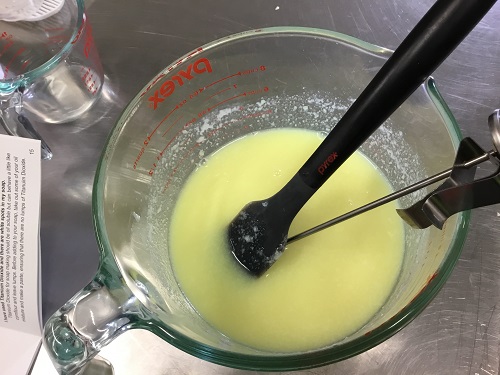
- While you are gradually adding caustic soda to the milk, go ahead and melt your palm and coconut oil. Then add your olive oil which will not need to be melted.
- Once you have your caustic soda/milk solution made up and your oils melted, you must equalise their temperature until they are the same, somewhere between 34 to 38 degrees. To do this, use hot and/or cold water in the sink and place the jug and/or bowl into the appropriate water. When they reach the same temperature, you are ready to mix them together.
- Once the oils and the caustic soda solution reach the same temperate, you can pour your caustic soda solution into your oil mixture. Wearing rubber gloves and safety glasses, slowly drizzle the caustic soda solution into your oils while mixing. If you are going to use a free-standing or hand mixer, it should be set at its lowest speed. A free-standing mixer allows you to move away when mixing and avoid getting any small splashes on you. If you use a handheld mixer or stick blender, be sure you have long sleeves and rubber gloves and that the bowl is big enough to work without getting splashed. It is faster with a stick blender.
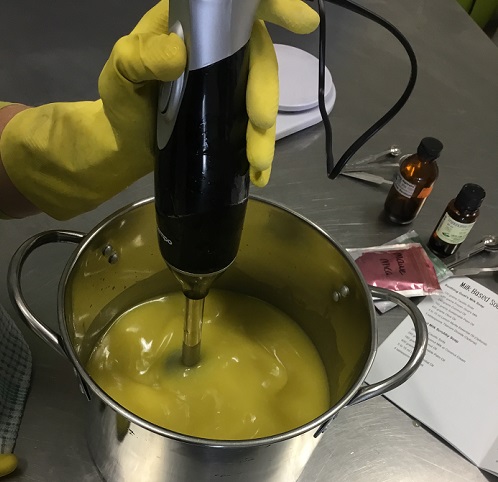
- Keep mixing until the soap mixture starts to thicken. As the mixture starts to thicken, you need to test for trace. To test for trace, use a spoon, pick up a small amount of the soap mixture, and drizzle it across the top of the remaining soap mixture. If it is not ready, the drizzle will immediately sink back into the soap mixture without leaving a trace. However, as it thickens and you test the mixture again, a small amount of the soap mixture drizzled onto the remaining soap mixture will leave a faint pattern before sinking back into the mixture. This is called trace. You do not want to wait until the trace is thick enough for the pattern to remain on the surface, as this will then be too thick to pour.
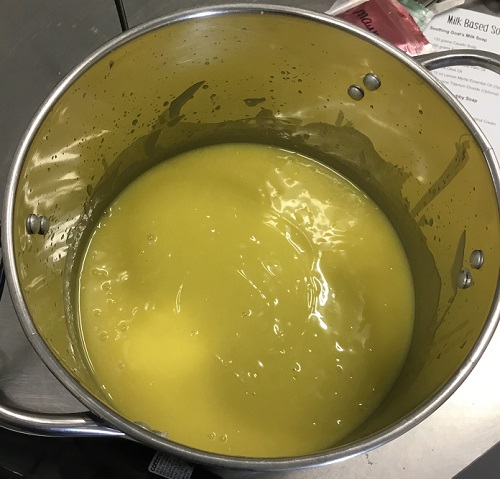
- Once your soap has reached trace, you can mix in your essential oils and colour. Mix in your essential oils.
- I used two colours to get the effect I was looking for. Pour about half of the soap mixture into another jug to do this. Then add the colours and mix them in.
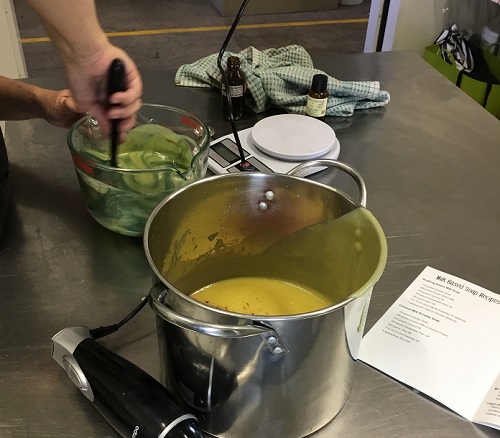
- If using silicone soap moulds, place them onto a tray, such as a baking tray. Carefully pour your soap into the mould(s).
- Begin to pour the soap into the corner of the loaf mould. Then change to the other colour and pour on top of the first colour. Continue to do this, changing colours back and forth until the mould is full.
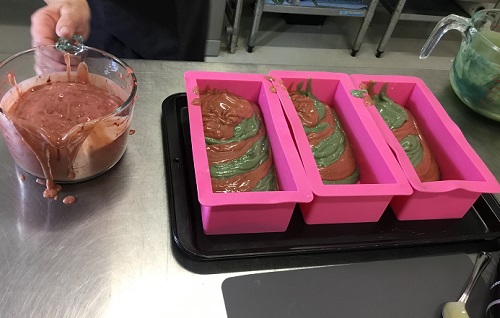
- If the surface is not smooth from when you poured your soap, give them a little shake, and it will smooth out. The same applies if you are using some other container as a mould.
- Cover your soaps with another tray or a cardboard box. Wrap your mould(s) in insulating material such as a blanket or old towels to keep them warm. Place them in a warm location. I usually use my kitchen, as this is the warmest room in my house.
- Allow your soap to sit undisturbed for 24 to 48 hours.
- Check your soaps for firmness. They should be firm to the touch but not rock-hard. If it is still too soft to remove from the mould(s) without damaging the shape of the soap, leave it longer. Once it is firm to the touch, simply pop the soap out of the mould.
- Cut your soaps to the size you want and place them on a plastic needlepoint screen, sushi mats, or something similar to air dry. You want something that will allow air to circulate around the soap. Turn your soap over once a week.
- Allow your soaps to cure for six weeks before using your soap. This allows for the saponification to be completed.
What you can do is limited only by your imagination. This simple goat’s milk soap smells divine, and I love the colour combination and random pattern. You will note that it looked a little thick when I was pouring it into the moulds. In truth, I mixed it just a bit too long as I was trying to get a good photograph of trace. Thinner would have been better.
As always, live well.
Valerie
Valerie, I have been using the room temperature method of making soap lately. Thankfully it has been working out well and is quick and easy. I just love goat’s milk soap. Thanks for the recipe.
Hi Valerie, what oil could I use as a substitute for the palm oil please? Can I use cows milk instead of goats as I milk a few dairy cows. Thank you.
Hi Theresa:
Palm oil is itself a substitute for animal fat, which I do not want to use in my soap making. You could use more coconut oil instead, but this soap is not quite as good. Palm and coconut are known as tropical oils as ther are fully saturated like animal fat. Other non-aminal fast/oils are either monounsaturated or polyunsaturated and while they have their place in soap making, the Palm and coconut give you a soap that lathers well and cleans well.
I use sustainable palm oil as if we do not support the villagers who provide this then they will have no choice but to give up their lands to clearing and palm farming. I am sure that feeding their children is their top priority so we should give them a hand and keep purchasing sustainable palm oil. It is a little more expensive but we can afford to be generous and pay that small extra amount.
I hope that this information is helpful.
Valerie
Hi Valerie,
What brand caustic soda is best used for soap (that is also relatively cheap)?
Thanks
Catherine
Hi Catherine,
I use the Green Living Australia brans, but it is only available at the Green Living Australia store in Underwood, QLD. Just look for one that is as pure as can be or says suitable for soap making on the package. I think they have one that says that in Bunnings, but I do not remember the name. It was in a blue bottle.
Valerie
Hi,
When I mixed goat milk with caustic soda my milk turned quiet dark yellow color but I didn’t feel any smell from milk. Is it wrong please explain me?
Thank you
Sahana
Hello:
You just need to monitor the temperature and make sure it does not get too hot a burn the milk. When you use water you just add the caustic soda all at once and it gets very hot, 90 degrees or more. With milk, you have to add it a bit a a time and keep the temperature down with an ice bath and frozen milk. Try to keep the temperate no higher that 38 degrees. My goat’s milk always goers yellow, and that is OK. If it burns, it is hot and smelly. Z
Valerie
Hi Valerie
A way to overcome the milk / lye mixture overheating is to place the frozen milk / lye container in a water bath. I also freeze small containers of water so that I can add ice blocks to this water bath.
Using a water bath is also useful to prevent lye mixture overheating when using beer or honey in soap making. Honey should be dissolved in water a few days before use though! I refrigerate my honey / water. Beer is also “cooked” a few days before use.
The lye mixture in a blue bottle you mentioned. Could it be “Diggers”? Unfortunately Diggers don’t produce lye anymore. I’ve recently bought Bonners caustic Soda from Bunnings.
Love your site. Thank you for great information.
Maureen (South Australia)
Maureen:
Thank you so much for joining the conversation and sharing your useful information and for your support. Valerie